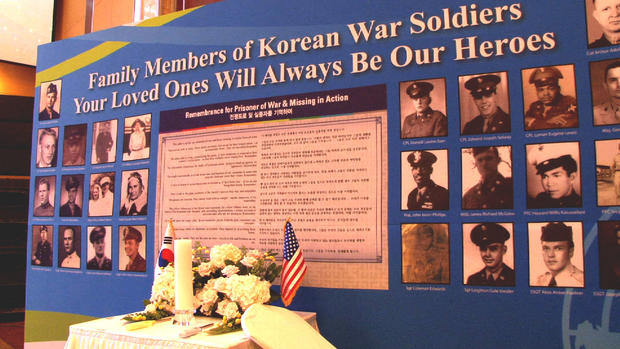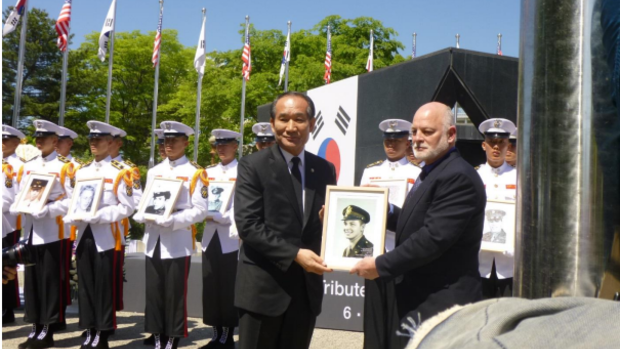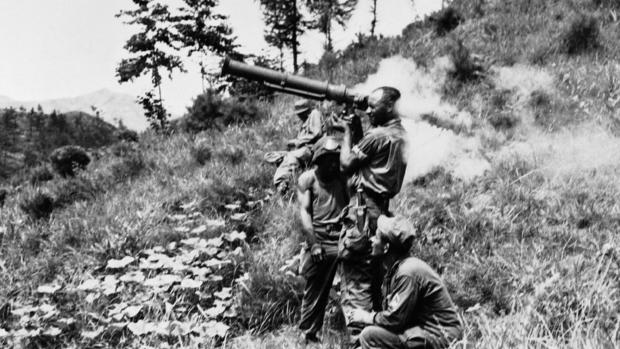Bringing home the missing soldiers of the Korean War
The phone rarely rang in Harlan Kreider's rural Iowa farm home and, at 15 years old, he was never allowed to answer it.
But as he walked in from doing his chores one February morning in 1951, there was no one else home to silence the incessant ringing of the phone on the wall. He picked it up. The town marshal was on the line with a message for his parents: Harlan's brother, Army Sgt. Leighton Gale Kreider, had gone missing in action while fighting in Korea earlier that month.
More than 60 years later, Harlan Kreider still choked up when he talked about breaking the news to his father.
"Probably the hardest thing in my life I've ever encountered," Kreider said, his lower lip quivering as a single tear ran down his cheek.
When he turned 18, Kreider joined the military in the hopes that he would be sent to Korea and be able look for his brother. He would never make it there.
In 1953, an armistice was signed, effectively giving the opposing sides political autonomy over their own territory. Everything north of the 38th parallel would be a communist state, everything south a democracy. Along the 155-mile line that bifurcated Korea, soldiers, weapons and barbed wire prevented access in either direction.
Kreider later learned that his brother likely died of gangrene or malnutrition in a North Korean mining camp in August of 1951. His body has never been found.
"I think I'm at final closure or as close as I'm ever going to get," Kreider said of losing his brother. "The only other thing would be to have his remains returned home but I've kind of been told that will probably never happen."
Sergeant Kreider is one of 7,846 U.S. service members who remain missing in action from the Korean War. A government agency known as the Defense POW/MIA Accounting Agency, or in the parlance of military acronyms DPAA, is tasked with trying to locate and identify the missing soldiers, sailors, airmen and Marines who never returned. Since 1982, DPAA (formerly known as the Joint POW/MIA Command, or JPAC) has accounted for the remains of just over 300 U.S. service members who disappeared in Korea.
Army Corporal Edward Solway, whose military contract was supposed to have ended before he was sent to fight, was not one of them.
"In 1950, President (Harry) Truman added a year on to everyone in the service," his brother, Larry Solway said. "My mother never, ever forgave President Truman for that, because when that year was added, my brother was sent over to Korea."
Corporal Solway was taken prisoner on May 18, 1951 and marched north toward a mining camp. Reports from fellow soldiers indicate he died of dysentery somewhere along the route, but no one knows exactly where.
When, where and how are questions that haunt the families of missing service members like John Zimmerlee whose father, U.S. Air Force Captain John Henry Zimmerlee Jr., went missing on March 22, 1952 during a night mission in a B-26B Invader bomber.
The Zimmerlee family hoped for answers when, in 1996, JPAC began conducting operations to recover the remains of about 5,000 U.S. servicemen believed to be buried in North Korea. But after 10 years and roughly 225 recoveries, the mission drew to a halt as a result of increasing tensions on the Korean peninsula.
Searching for an alternate route to information about what happened to his father, Zimmerlee began making trips to the National Archives in Maryland to search though old Korean War files.
"During my research there I was uncovering all sorts of information about everybody else's cases. I realized that I would be so grateful for that information on my father, other families would be grateful if I passed it along to them," Zimmerlee said. "I created a database and I started sharing information with the other families and it's been one of the most gratifying things I've ever done in my life."
In May, Zimmerlee was able to share the information he collected with the families of two-dozen missing U.S. service members. They'd all been invited on a trip to Korea, sponsored by the South Korean government, to visit the country where their loved ones were last seen alive.
Most of the families knew little about the circumstances surrounding their loved one's disappearance.
"He vanished into thin air," Jeanne Brown said of her father, Army Master Sgt. James McGrew who was taken prisoner in North Korea on Nov. 30, 1950.
Throughout her childhood when Brown blew out the candles on her birthday cake, she wished that her father would come home. Now she knows there's a chance her father might already be back on American soil.
More than 400 Korean War unknowns are buried at the National Cemetery of the Pacific in Hawaii, returned by the North Koreans during "Operation Glory" in 1954. Another possible 300 unknowns, handed over by the North Koreans in the 1990's, currently await identification at DPAA's lab in Hawaii. Brown believes there is a 50 percent chance her father is there.
"My mother passed away and she's buried at the National Cemetery," Brown said. "If my father's remains or body are ever found, he will be buried there with her, but I don't know that will happen in my lifetime."
That's because there's another 50 percent chance that her father's remains are still in North Korea where, in October 2014, the Korean People's Army (KPA) warned the bodies of American servicemen killed in the Korean War were in danger of being lost.
"Lots of remains of GIs are left here and there uncared and carried away en masse due to construction projects of hydro-power stations, land rezoning and other gigantic nature-remaking projects," a statement from the KPA read.
Still, Brown refuses to relinquish hope.
"Miracles do happen. Other governments have opened up. Cuba has opened up now. The Berlin wall has gone down in the past 25 years. Things have happened."
Some families refuse to fully accept that their loved one is dead. Lorna Akima's brother, Marine Corps Private First Class Howard Kaiuwailani, went missing in action on March 26, 1953 near the border between North and South Korea.
"Without any proof, I'm still holding hope that, well, they're still alive," Akima admitted.
The Department of Defense hasn't given up on that possibility. The DoD, along with the U.S. intelligence community, still investigates all credible reports of American survivors in North Korea. Since 1995, American agencies have screened more than 25,000 defectors from North Korea for information about missing American service members. None have yielded useful information.
For their part, representatives of the South Korean Ministry of Patriots and Veterans Affairs, who are currently searching for 130,000 missing Korean troops, told the families who visited in May that they will do everything possible to recover the remains of men they say will always be their heroes.
"What I want to do is bring closure to all of this," Akima said during the trip to South Korea. "I think my being here, I'm getting closer to closure. I might be walking the street or the road that my brother walked on and I think that might help me find closure."
Marilyn Beecham feels much the same way. Her father, Tuskegee Airman 1st Lt. Newman Golden, took a direct hit by anti-aircraft fire in his F-51D Mustang night fighter on October 17, 1951. As a young girl, Beecham always thought her father would come back one day. She now accepts that will never happen, but remembers fondly the father who sent her a kimono from Japan and a letter describing why he believed in his mission, bringing peace to millions.
"I like the memory of remembering him the way he left. So to me, this is bringing him home. The fact that I know he was here at the point of his life and if that never happens with bringing him home, I'm okay with it," Beecham said, just prior to adding, "But it would be nice to be able to say, here he is. "



